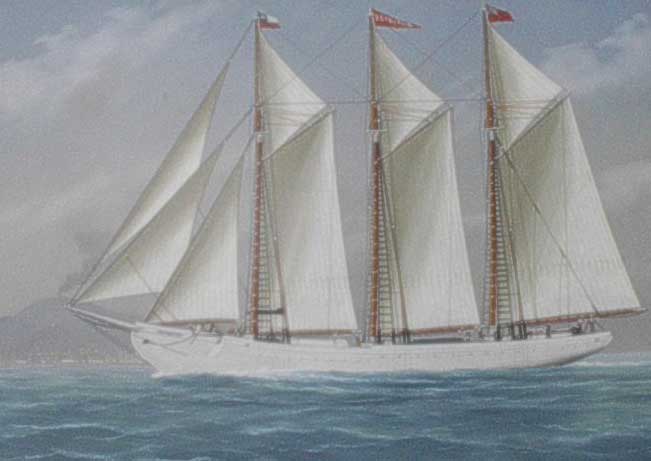
Retraction entering Bay of Naples, 1923, watercolour by unknown Neapolitan artist
Declaration of Loss of Vessel

Retraction entering Bay of Naples, 1923, watercolour
by unknown Neapolitan artist
The Retraction was a "tern" schooner. Three masted with an overall length of 119 feet, beam of 26 feet, and a draft of 11 feet, she was built in Conquerall Bank, Nova Scotia by the firm of J.N. Rafuse for Philip Templeman of Bonavista; she was a sister ship of the Ricketts, V.C. built in 1919 for William Forsey of Grand Bank and lost near Petit Bois Island, Miss., 26 August 1921. Rafuse built five terns on the Retraction and Ricketts, V.C. model in 1919, and the Retraction and two others in 1920. See Sails of the Maritimes by John P. Parker, M.B.E., Master Mariner (Parker, 1960) for details regarding the three and four masted schooners built in Canada and Newfoundland between 1859 and 1929.
Captain Sinclair unofficially still holds the fastest sailing record between St. John's and Belize, British Honduras, 26 days down and back, set in the Retraction in 1924.
On the return from Cadiz with a load of salt, the Retraction suffered heavy weather and was abandoned about 1000 miles south of Cape Race. His crew included his brother Max, as Mate; Seamen Abner Brennan, Samuel Chapland and Max House; and Cook S. Steeds. Rescued by a British oil tanker S.S. El Oso and taken to Curaco in the British West Indies, they were returned to New York on S.S. St. Agnes and from there to St. John's on the Red Cross liner Rosalind.
The first duty of a captain of a lost vessel, upon rescue, is to make a formal declaration of the incident. This facsimile is of a carbon copy typescript provided by the radio operator of the S.S. El Oso to Captain Sinclair. For 12 days he and his crew battled against the "perfect storm" of 1926. Privately he claimed he always knew the Retraction was "weak in the keel" and blamed this fault on her eventual demise. His daughter Nina Marie was born on February 2 at Devon House, Duckworth Street, then the Templeman family home, where his family had taken refuge while awaiting news of the ship's fate as it was long overdue. He arrived back in St. John's on March 14.
The facsimile repeats original spelling mistakes. Click here to see scan of original document.
|
FEBRUARY 6 th 1926 This is to certify that I, John Sinclair, Master of the British
Schooner "Retraction" of 148 tons nett, owned by Philip Templeman of
St. John's, Newfoundalnd, make the following declaration:- |